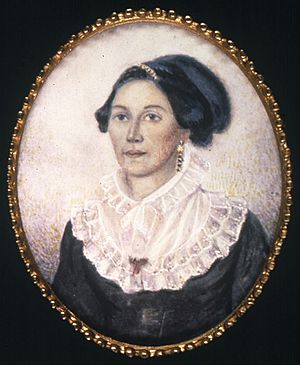Elizabeth Brant (Mohawk Leader) facts for kids
Quick facts for kids
Elizabeth Brant
|
|
|---|---|
 |
|
| Born | 1796 |
| Died | April 25, 1845 Wellington Square, Canada West
|
| Spouse(s) | William Johnson Kerr |
| Children | William Simcoe Kerr |
| Parent(s) | Catharine Brant Joseph Brant |
Elizabeth Brant, also known as Elizabeth Kerr, was an important leader among the Six Nations of the Grand River. She was a Clan Mother, a respected position of power in her community. Elizabeth was the daughter of Catharine Brant and Joseph Brant, both well-known figures. In the Haudenosaunee culture, leadership and family lines often passed down through the mother's side. This is called a matrilineal society. Because of this, Elizabeth inherited her role as a Clan Mother from her mother.
Contents
Who Was Elizabeth Brant?
Elizabeth Brant was born in 1796 in a place then known as Upper Canada. This area is now part of Ontario, Canada. She grew up in a time when Indigenous peoples and European settlers were interacting a lot. Her family was very influential in the Mohawk nation.
Her Family and Marriage
Elizabeth Brant married William Johnson Kerr. He was the grandson of two important people: Molly Brant and Sir William Johnson. Elizabeth and William had five children together. They were a wealthy and respected family in Upper Canada. They owned a lot of land. In 1819, a British official described Elizabeth Brant as a "charming, noble-looking Indian girl." She often wore a mix of traditional Indigenous and English clothes.
Elizabeth Brant's Leadership Role
Elizabeth Brant was a key leader on the Grand River, just like other members of her family. Her family played a big part in guiding the Mohawk nation.
Supporting Her Brother
Elizabeth's brother, John Brant, became a very important civil chief of the Mohawk. This role was called the Tekarihogen. Their mother, Catharine Brant, chose John for this position in 1828. Since John never married, Elizabeth managed his home and supported him.
Passing on the Leadership
After John Brant passed away in 1832, Catharine Brant chose Elizabeth's son, William Simcoe Kerr, to become the new Tekarihogen. This showed the continued importance of their family in leadership. When Catharine Brant died in 1837, Elizabeth Brant became the most important woman leader of the Mohawk nation on the Grand River. She continued to guide her community until her death in 1845.

